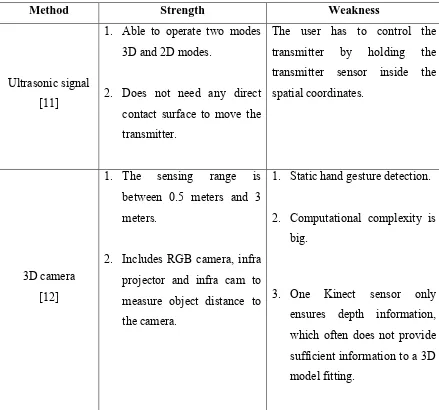i
TOUCHLESS 3D CONTROLLER USING CAPACITIVE SENSING METHOD
NUR SHAZWANI BINTI AMINUDDIN
This Report Is Submitted In Partial Fulfilment of Requirements for The Bachelor Degree of Electronic Engineering (Computer Engineering)
Faculty of Electronic and Computer Engineering Universiti Teknikal Malaysia Melaka
v
vi
APPRECIATION
With boundless love and appreciation, I would like extend my heartfelt gratitude to the people who helped me in bringing this project into reality. Therefore, I would like to extend my profound gratitude to the following:
My supervisor for this project Dr. Syafeeza bt Ahmad Radzi whose guidance has helped me into bringing this project into success with her the time spent and consistent advice that has helped me.
To my second supervisor Dr. Maisarah bt Abu who has willingly helped me into accepting my project idea from day one and for her suggestion and favourable response to my project idea regarding it.
To all my friends, classmates and Dr. Kok Swee Leong who is final year student coordinator that helped in transferring valuable info about the project progress and requirement needed so that the project well done achieve.
Lastly, not forgetting is to my family who supported me from behind morally and financially in order to finish this project.
vii
ABSTRACT
viii
ABSTRAK
ix
CONTENT
CHAP TITLE PAGES
PROJECT TITLE i
VERIFICATION FORM ii
STUDENT CONFIRMATION iii
SUPERVISOR CONFIRMATION iv
DEDICATION v
APPRECIATION vi
ABSTRACT vii
ABSTRAK viii
CONTENT ix
LIST OF FIGURES xii
LIST OF TABLES xiii
LIST OF ABBREVIATIONS xiv
1 INTRODUCTION
1.1 BACKGROUND 1
1.2 OBJECTIVES OF PROJECT 2
1.3 PROBLEM STATEMENT 3
1.4 SCOPE OF PROJECT 4
1.5 REPORT STRUCTURE 5
2 LITERATURE REVIEW
2.1 INTRODUCTION 6
x 2.3 PRINCIPLE OF CAPACITIVE SENSING 12
2.3.1 E-Field 13
2.3.2 Challenges 15
3 METHODOLOGY
3.1 INTRODUCTION 17
3.2 HARDWARE FEATURES 20
3.2.1 3D Sensor Cube 20
3.2.2 Circuit and wires 23
3.3 SOFTWARE 25
3.3.1 Arduino Ide 25
3.3.2 Processing 26
3.3.3 Matlab 27
3.4 DISCUSSIONS 20
3.5 CONCLUSIONS’ 21
4 RESULT AND ANALYSIS
4.1 INTRODUCTION 28
4.2 CAPACITIVE VALUE IN REAL TIME 29 4.3 SERIAL COMMUNICATION
BETWEEN ARDUINO AND MATLAB
SOFTWARE 33
4.4 3D INTERFACES OF THE CAPACITIVE SENSING WITHIN THE SENSOR CUBE
USING PROCESSING SOFTWARE 36 4.5 HUMAN COMPUTER INTERACTION 38
xi
5 CONCLUSION AND FUTURE WORK
5.1 CONCLUSION 41
5.2 FUTURE WORK 43
xii
LIST OF FIGURES
NUM TOPICS PAGES
2.1 Types of gesture control methods 7
2.2 Undistorted E-field 14
2.3 Distorted E-Field by hand 15
3.1 The work flow 18
3.2 Block diagram of the system 19
3.3 The sensor cube 20
3.4 Illustration of the sensing region 21
3.5 The final look of 3D sensor cube 22
3.6 The schematic diagram of the circuit 23 4.1 Serial monitor of Arduino IDE display capacitive value 29 4.2 The first column capacitance value is increasing 31 4.3 The first column capacitance value is increasing 31 4.4 The first column capacitance value is increasing 32 4.5 The graph shows the capacitance value activity on
the blue marker 34
4.6 The graph shows the capacitance value activity on
the green marker 34
4.7 The graph shows the capacitance value activity on
the blue marker 35
4.8 Hand movement within the sensor cube 36
4.9 Interface of the sensor cube 37
4.10 Google Earth program controlled by the 3D sensor cube 38
xiii
LIST OF TABLES
NUM TOPICS PAGES
2.1 Comparisons between methods 9
4.1 Reference values assigned to each plate 30
xiv
LIST OF ABBREVIATION
2D - Two dimensional
3D - Three dimensional
E-FIELD - Electric field
HCI - Human-computer interactions IDE - Integrated development environment RFID - Radio-frequency identification DOF - Depth of field
DC - Direct current AC - Alternating current
RX - Receiver
COM - Communication port USB - Universal Serial Bus
UART - Universal asynchronous receiver/transmitter
IR - Infrared
1
CHAPTER 1
INTRODUCTION
1.1 Background
2 The purpose of this project is to develop a touchless control device in three dimensional areas of interactions by gestural movement in the air for interaction with computers. The method used to develop the 3D controller is by using capacitive sensing. Capacitive sensing method uses electrodes as sensor input. The electrodes act to detect the E-field variations at different positions in order to measure the origin of the electric field distortion from the varying signals received due to the conductivity of the human body itself that shunted to ground [2]. Then the information is used to calculate the position, track movements and to classify movement patterns (gestures).
This method uses three aluminium foil board and building it in cube form with each plate act as x, y and z coordinates. The cubes are conductive so that it can store capacitive charge with current and voltage supplied by the Arduino UNO. The Processing software is used to display the tracking interface of the sensor when it detects our hands within the sensor region. MATLAB software used to build a serial connection between Arduino and the software so that the cube sensor can establish a mouse control for user computer interface control.
1.2 Objectives of project
This project is mainly about using gestural control as input for computer user interactions. Therefore, the objectives are:
i. To develop a 3D interface for gesture control by using capacitive sensing ii. To construct a low cost 3D gesture controlling device.
3
1.3 Problem Statement
There has been a surge interest for a touchless human computer interactions system. The HCI (human-computer interactions) can be defined as the study, planning, design and the uses of human interface between the users and computers. Most developer wants to have the best fit in the designing of HCI. The important is to know the activity those are to be done for HCI. For example the material that are being used needs to be durable, the development of the hardware needs to be cost effective and also the important is for it to fit among users, computers and all the task it will corresponding. Therefore, the main objective for HCI is to get feedback from users about their experience with the available prototype and the developer will refine the design based on the comments and suggestion given by the user [3]. Thus the HCI designed by using a touchless system has taken its place in the market with best possible performance to fit the user. For an example, Microsoft Kinect which uses gestural input movement for gaming purposes. The technologies are based on infrared projector and camera to track the gesture. However there are drawbacks from using camera as gestural input such that:
i. The product device for 3D camera is very expensive with estimated value nowadays in the market is more than RM200.
4
1.4 Scope of Project
5
1.5 Report Structure
In this thesis, there are five total chapters that consist of introduction, literature review, methodology, results and discussions and for the last chapter is the conclusion and recommendations for the project.
For Chapter 1, the introduction for project is explained. The contents of the first chapter are the background and objectives for the project. Furthermore, the problem statement that inspired for making this project was thoroughly explained and lastly in this chapter is the scope of work for overall overview of the 3D Gesture Controller Using Capacitive Sensing method development project.
Chapter 2 discusses about the literature review of the capacitive sensing method in gestural movement and its comparisons with other methods based upon previous research and also from multiple sources (internet, magazine and data sheet).
Chapter 3 will explain the methodologies used in the project. It will explain the steps and flow of the project for design and develop the 3D gesture controller. The specification and the layout circuit design and software implementation are explained in this chapter.
Chapter 4 describes the results and analysis obtained upon developing the project and justifies its performance in making sure it meets the objective of the development of the project.
6
CHAPTER 2
LITERATURE REVIEW
2.1 Introduction
7 Figure 2.1 shows the different type of gesture controller method that can be used to develop a touchless controller. Based on the figure, capacitive sensing method is chosen in this for project in order to develop a touchless 3D controller.
Figure 2.1: Types of gesture control methods
2.2 Hand Gesture Controller
8 depth data by projecting a grid of infrared dots and observing the shift in pixels with respect to a known pattern. This allowed for games to be controlled entirely through gestures and without the requirement of a physical controller [10]. It is common methods that were actually used to develop gestural recognition are by using a camera. By this method it must follow these three steps; segmentation, representation and recognition.
9
2.2.1 Comparison between methods
[image:23.595.109.548.284.694.2]There are many methods and approaches used in making a touchless interface. The methods are different in the form of type of hardware used in making a system. The comparisons between methods are listed based on their strengths and weaknesses as shown in table 2.1 below.
Table 2.1: Comparisons between methods
Method Strength Weakness
Ultrasonic signal [11]
1. Able to operate two modes 3D and 2D modes.
2. Does not need any direct contact surface to move the transmitter.
The user has to control the transmitter by holding the transmitter sensor inside the spatial coordinates.
3D camera [12]
1. The sensing range is between 0.5 meters and 3 meters.
2. Includes RGB camera, infra projector and infra cam to measure object distance to the camera.
1. Static hand gesture detection.
2. Computational complexity is big.
10
Driven by a depth sensor, to a virtual
camera manipulator,
allowing for direct control of 4
DOFs of navigation
[13]
1. Body-driven 3D navigation interface for large displays and immersive scenarios.
2. Operates with simple pose recognition scheme.
1. NuNav3D was on average 79.9% slower than the joypad controller.
2. Over translate the virtual
3. Camera when using Nunav3D, which resulted in corrective manoeuvres when exiting the tight constraints of the path-following task.
Kinect sensor [14]
The average accuracy for gesture classification is 93%, and the total time required to cover all controls of 3D medical viewer is about 2.25 minutes on average
1. Have some limitations on finger tracking algorithm and design.
2. Slice selection to the selection to a specific slice is quite difficult thus slowing it.

